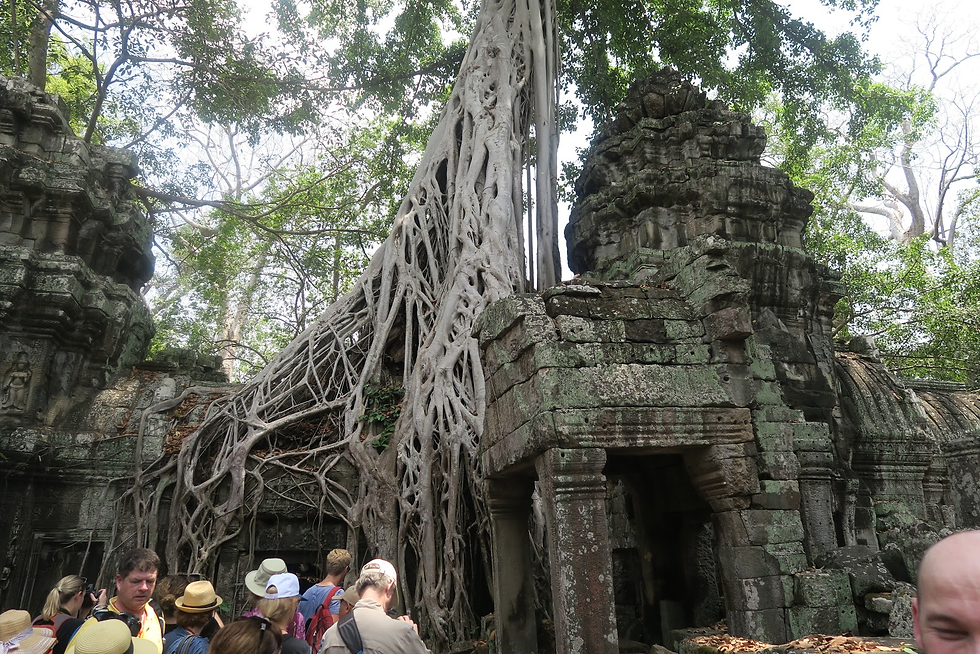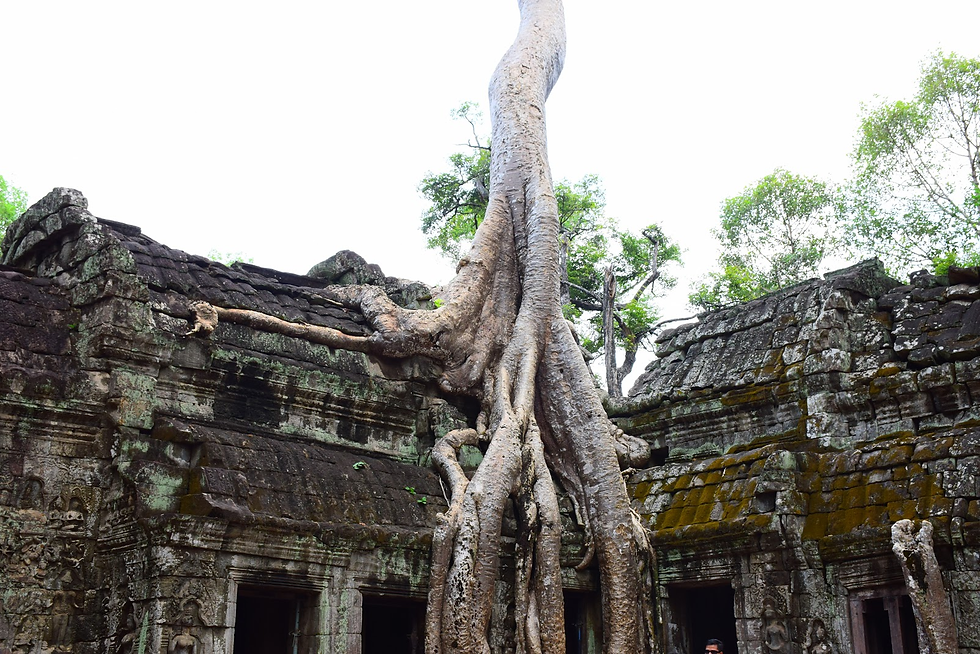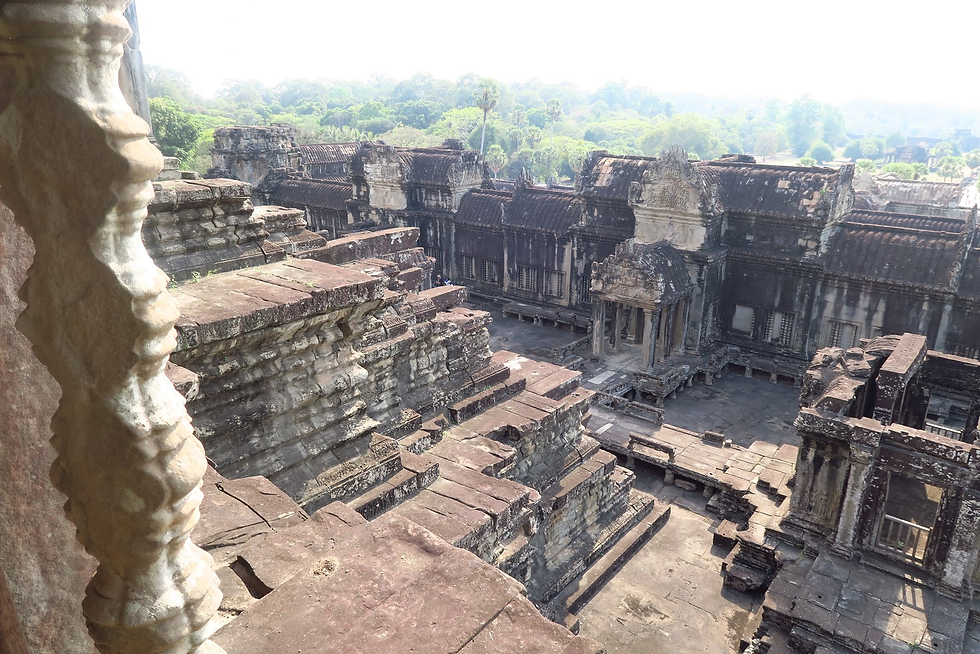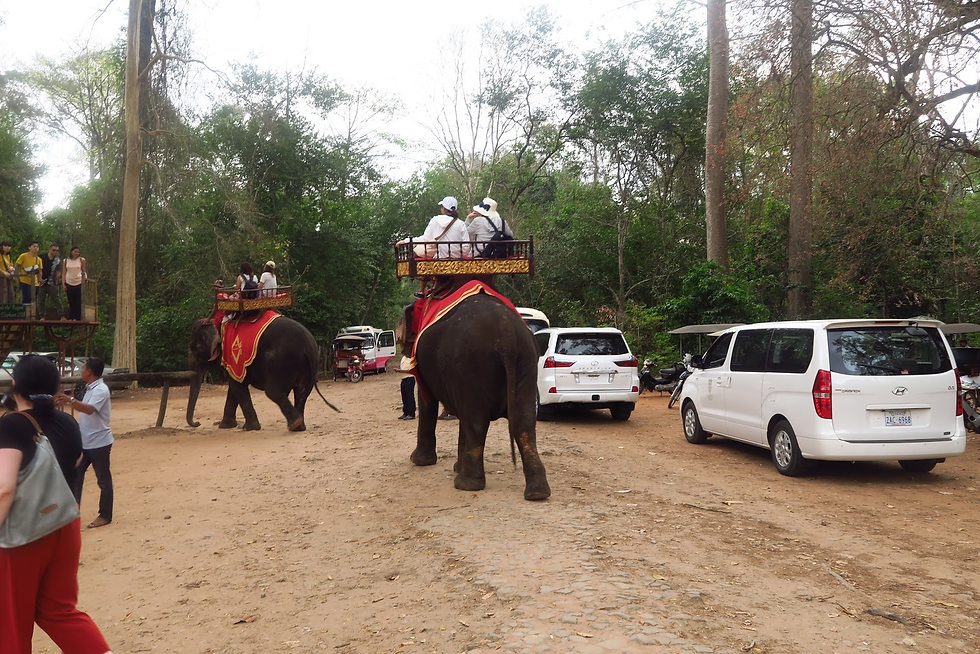Angkor Complex of Temples, Cambodia
- AbouTravel.

- May 9, 2022
- 4 min read
Updated: Jul 8, 2022
The Angkor religious complex of temples and ruins is Cambodia's most popular landmark, a world-famous attraction that annually receives over 2 million visitors, making it one of the world's most visited attractions with great historic significance.
It is located about six kilometers (four miles) north of Siem Reap.
Angkor's history is related to the impressive Khmer Empire, which flourished from the 9th to 15th centuries and Angkor served as its capital city.
Today is considered the world's largest religious complex of temples located in the jungles of Cambodia.
The temples of the Angkor area number over one thousand, ranging in scale from nondescript piles of brick rubble scattered through rice fields to the Angkor Wat, said to be the world's largest single religious monument.
At its zenith, the city's population numbered one million people, considered to be the largest preindustrial city in the world.
After the fall of the Khmer empire, the Angkor temples were abandoned and reclaimed by the jungle for centuries. Situated amid dense rainforest and rice paddies, many of the temples at Angkor have now been restored.
Angkor Wat and Angkor Thom are collectively protected as a UNESCO World Heritage Site.
Seeing all the temples of Angkor is almost impossible or at least you need to spend a week at the place.
The main temples of interest that are most visited by tourists are Angkor Wat, Angkor Thom South Gate, Bayon, and Ta Prohm (The Tomb Raider Temple).
In addition, you may also consider seeing other temples like Banteay Srei, Phnom Bakheng, Preah Khan, Pre Rup, Banteay Kdei, Ta Keo and more.
Best time to visit Angkor which is also the peak tourist season is from December to April when rainfall is less likely and the climate is most kind.

Angkor Wat
Angkor Wat is the most famous and largest of all Angkor's temples. It means “City of Temples”.
The magnificent temple was built in the 12 century by King Suryavarman II as his state temple and eventual mausoleum.
The structure occupies a vast area of nearly 200 hectares (494 acres).
The arrangement of Angkor Wat was designed to reflect the traditional Khmer idea of the temple mountain, in which the temple represents Mount Meru, the home of the gods in Hinduism.
Originally constructed as a Hindu temple dedicated to the god Vishnu for the Khmer Empire, it was gradually transformed into a Buddhist temple towards the end of the 12th century.
Unlike other temples at Angkor which were abandoned after the fall of the Khmer empire in the 15th century, Angkor Wat remained a Buddhist shrine until the 1800s, then fell into disuse. The French explorer Henri Mouhot rediscovered Angkor Wat in the 1860s.
As the best-preserved temple at the site, it is the only one to have remained a significant religious center since its foundation.
It has become a symbol of Cambodia, appearing on its national flag, and it is the country's prime attraction for visitors.
Very popular and highly recommended is to book a sunrise tour of Angkor Wat when you can admire spectacular sunrise scenes over the remarkable temple.





Bayon Temple
Built in the 12th century by King Jayavarman VII as part of a massive expansion of the last capital of the Khmer Emire - Angkor Thom, the Bayon stands right in the center of the royal city.
Originally built as a Mahayana Buddhist shrine dedicated to the Buddha, after Jayavarman’s death, it was modified by later Hindu and Theravada Buddhist kings in accordance with their own religious beliefs.
The well-preserved temple is most famous for the 216 massive stone faces that adorn Bayon's towers, looking in all directions.
There are different beliefs about who is depicted in the serene and smiling faces.
According to many, they are a portrait of King Jayavarman VII himself or a combination of him and Buddha.
Another distinctive feature of Bayon you can't miss seeing is its remarkable bas-reliefs - carvings. Stretching for about 1,2 km, the interesting carvings depict scenes from everyday life, historical events and stories from mythology. Some of the figures depicted are Siva, Vishnu, and Brahma.






Ta Prohm ( Tomb Raider Temple )
Ta Prohm is one of Angkor's most impressive and visited temples, known for the remarkable trees growing out of the ruins surrounded by lush vegetation.
The temple was built in the late 12th and early 13th centuries by King Jayavarman VII as a Mahayana Buddhist monastery and university.
It was originally named Rajavihara or "Monastery of the King".
The site was home to 12,500 people, including 18 high priests and 615 dancers.
After the fall of the Khmer empire in the 15th century, the temple was abandoned and neglected for centuries.
When the preservation and restoration works of Angkor's temples began in the early 21st century,
it was decided that Ta Prohm would be left largely as it had been found, so the jungle surroundings and wild spirit of the site would be preserved. Restoration works are still ongoing at Ta Prohm.
Visitors can admire and take great photos of the roots of the (Banyan) trees crawling around the ruins.
Ta Prohm is also known as "Tomb Raider Temple" since the temple served for the mystical setting of the 2001 Holywood movie starring Angelina Jolie.







Angkor Thom South Gate
Angkor Thom was the last and most enduring capital city of the Khmer Empire. It was established in the late 12th century by King Jayavarman VII.
A popular stopping place at Angkor Thom is the South Gate, which is one of the 5 gates that guard Angkor Thom. It is the best-preserved and most popular gate to enter the city.
It was built by King Jayavarman VII in the 12th century.
Before going through the Gate you will see unique sculptures lined on both sides of a bridge greeting you with smiling or stern faces.
On the left-hand side are lined 54 figures of Gods (Devas) and on the right-hand side there are 54 figures of Demons (Asuras).
Both rows look like they are playing tug of war, fighting for immortality.
It's a great place to stop and take photos with the Gods and (or) with the Demons.





























Comments